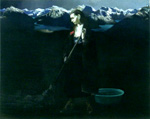|
Dace Liela graduated from the Art Academy of Riga in the department of monumental painting and received a stipend from the USSR Artists Union for further studies. Active as a painter and a book illustrator, she has exhibited internationally, and was represented by Sovavant-garde Gallery in Moscow and Tea Fisher-Reinhard Gallery in Berlin. Her works are in numerous private and public collections including the Latvia State Museum and Tretjakov National Gallery in Moscow. Her work refers to historical painting that she infuses with a contemporary realism.
|

7:00 A.M., 1992
1.6 x 2 m |
|
INTERPRETATION
While there is a heroic gesture in much of her works, almost all of the paintings have something to do with the position of women in society. 7:00 a.m. depicts a woman dressed with a black negligee with a red rose, set in front of Peyto Lake in the majestic Canadian Rocky Mountains where she is mopping the ground as if it were a kitchen floor. It may suggest that in spite of one’s beautiful surroundings or position, a woman’s servile role may be her inevitable destiny.
In the Forest depicts two women dressed in traditional attire winding their way through a deep, dark forest, picking mushrooms or searching for something, possibly bodies. There is a somber tone surrounding this work evident in the cross-hatched pattern of the overpainting, reminiscent of traditional decoration and weaving that seems to be straining to make itself prominent.
Here the Two Venuses are shattered and surrounded by cobwebs but are reforming themselves to emerge from history. One is putting on her nylon stockings yet casting a questioning glance. As they leave the classical world and enter the present, they have become “real” women but are now faced with the drudgery of everyday housework.
Creugas and Damoxenos is an ironic twist on the ancient Greek myth where, as the story goes, “Pausanias describes an incident at the Nemian Games where the boxer Creugas was awarded the victory – although he was dead. His opponent, Damoxenos of Syracuse, landed a foul blow under Damoxenos' rib cage and penetrated the intestinal cavity. Pausanias writes that Creugas then grabbed Damoxenos' intestines, and pulled them out, whereupon Creugas died on-the-spot. Damoxenos was disqualified by the judges and a victory statue was ultimately raised in the memory of Creugas at his home city, Argos.”
Theseus and the Centaur suggests a dream state where we witness a Greek sculpture transform itself into a beautiful young woman – possibly an escapist dream of another utopian life.
|



